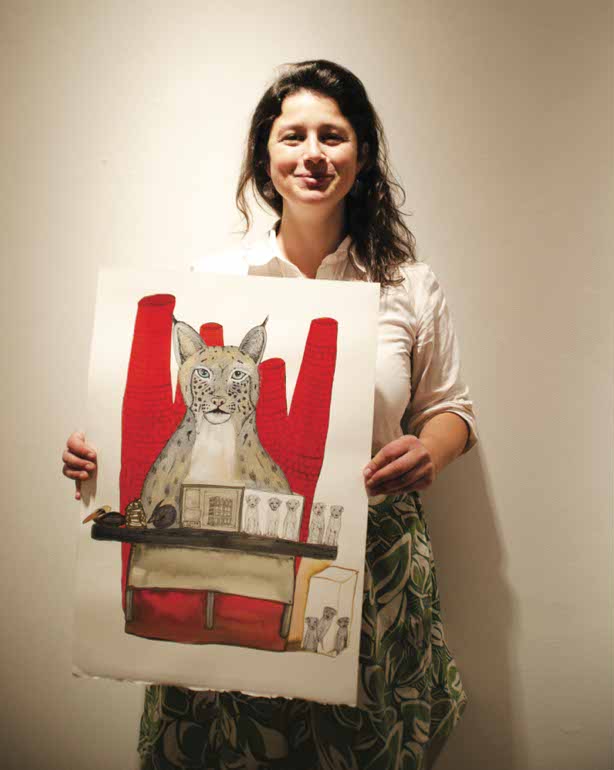Claire Siepser scribbles rough sketches of ideas that inconveniently pop into her head, reaching for a napkin, receipt or any available surface she can find while driving, shopping or doing anything far from her studio.
Siepser, a graduate student earning her master of arts degree in printmaking, is inspired by everyday life. Her most recent inspiration led to “Menagerie,” an art exhibit focusing on her personal experiences that will be held in the Ferguson Center Art Gallery from Nov. 5-26 with an opening reception Thursday from 5-8 p.m.
The exhibit focuses on prints and paintings that portray different emotions by putting animals in human situations. Her paintings are hung by pins and unframed intentionally while her prints are framed and matted to show enclosure. She mostly used ink, brushes and pens, although the prints are etchings.
Siepser carefully chose the animal she wanted to use in a certain piece, to make her work more relatable. Greg Randall, Siepsers colleague and a senior majoring in printmaking and photography, said the animals allow anyone to relate to a piece by letting people put themselves in the painted moment.
“Claire really wants to engage the viewers in multiple ways and try to pull them out of their normal everyday experience and allow them to experience something that is kind of magical,” Randall said.
Artists must first master technical skills before they can add their own ideas. Jessica Peterson, a printmaking and book art professor, said the difficulty lies in mastering the techniques. Successfully portraying personal perspective can also be challenging as students are exposed to professors’ work that can be easy to simply emulate.
“The best thing artists can do is be true to themselves,” Peterson said. “The challenge of art school is finding your own voice and having your art be strong and powerful.”
Siepser refuted the misconception of the abstract artist flinging paint left and right to create a masterpiece. She said her favorite part is the beginning and end. In the beginning, the excitement of the ideas and the details carry away her imagination. In the end, the completed work shines with the vision she so laboriously tried to create. In between is tiresome work. Her muscles ache as she hunches over her piece with repetitive small strokes. Hours of technical execution challenge her.
“Ultimately, it’s incredibly fulfilling, but it’s like digging a hole for a tree,” Siepser said.
Randall said Siepser’s lines are very detailed and cannot be completely grasped in the few seconds most viewers give to art displays. He said it is rare for people to give the full amount of time it takes to truly experience a piece.
“I think you have to stand and look at something for more than just a moment. You can’t take the whole thing in at a glance. There’s more detail put in than you can take in within just one moment,” Randall said.
Siepser said her work usually comes from a less personal place. However, these paintings are moments in her life, and the animals are inspired by people she encountered. She said even though there may be only one person able to recognize the painting as an exact moment in her life, they are relatable.
“These are pieces of architecture from my life that are distorted by memory,” Siepser said. “Every item is so specific to my life, but somehow, because they are so personal, people can relate to it.”
Siepser said she cannot define her artistic style since she works with such a variety of materials and images. Siepser works with whatever medium expresses the ideas and stories she is exploring and tries to make an interactive experience for the viewer. She said she views art outside of the traditional structure, seeing it in cooking, planting and every creation.
“Art is important to everybody. They just may not realize it,” Siepser said. “You can exist without art, but you can’t live without it.”









